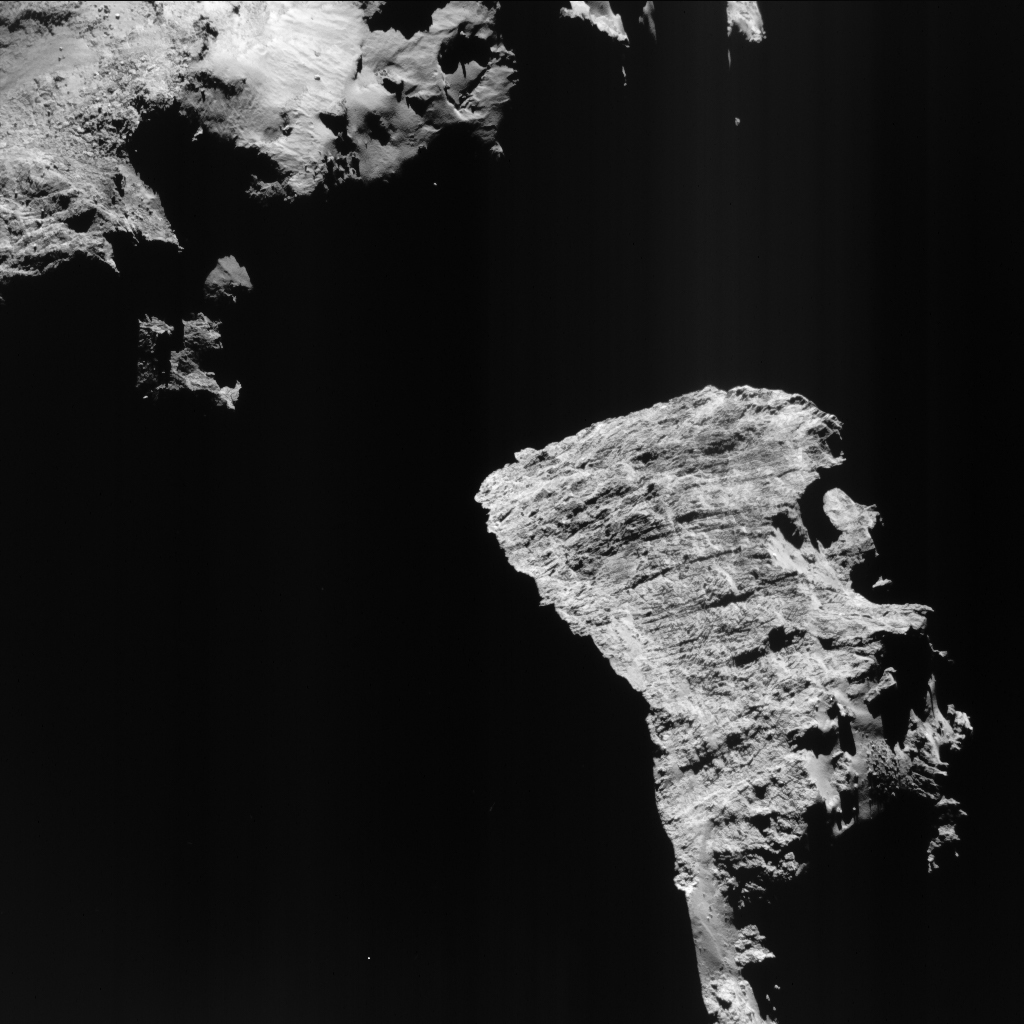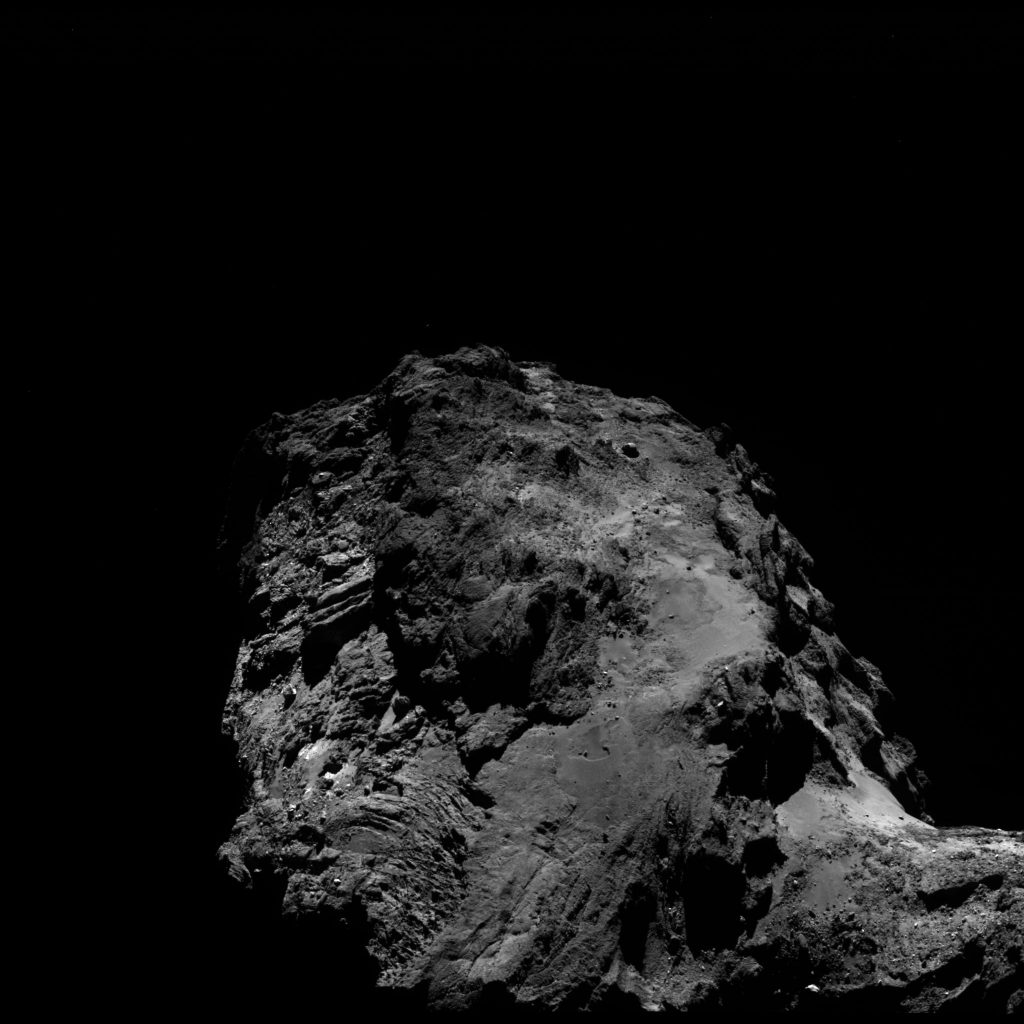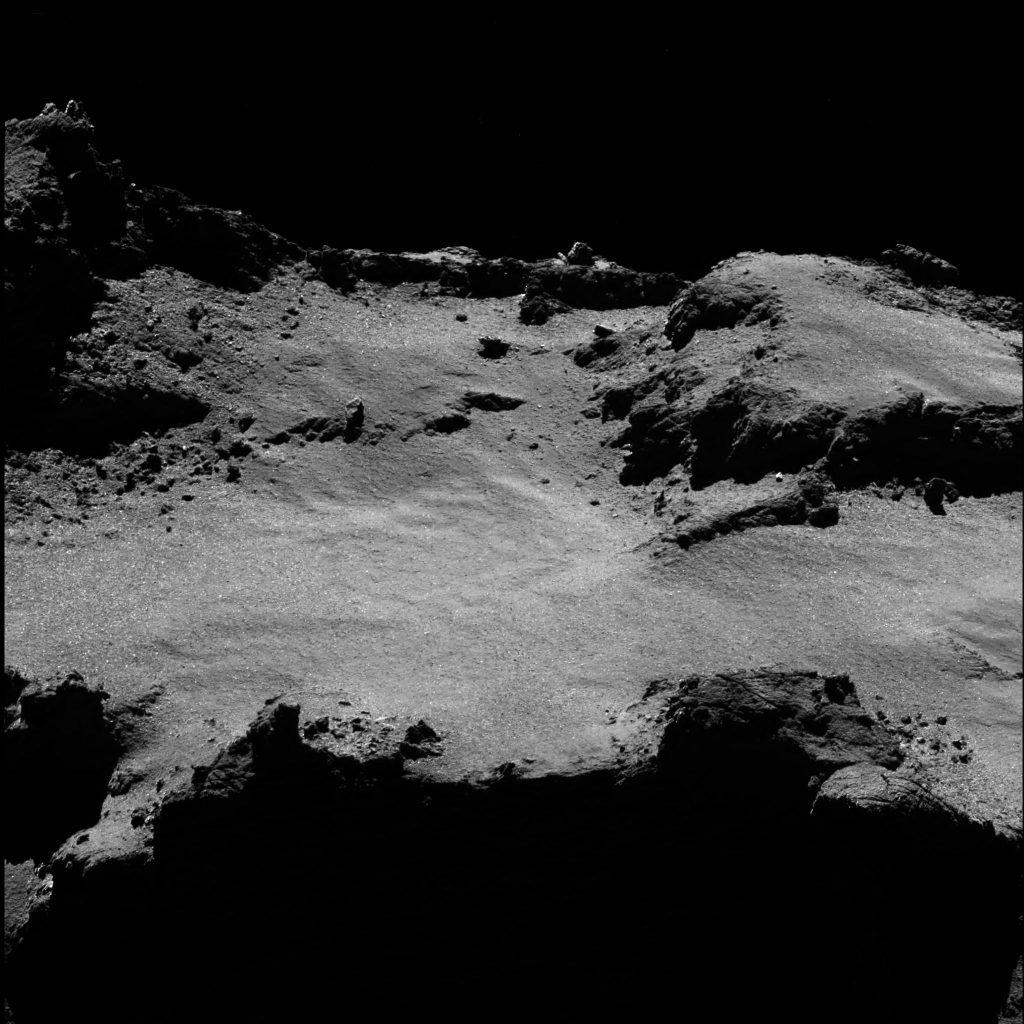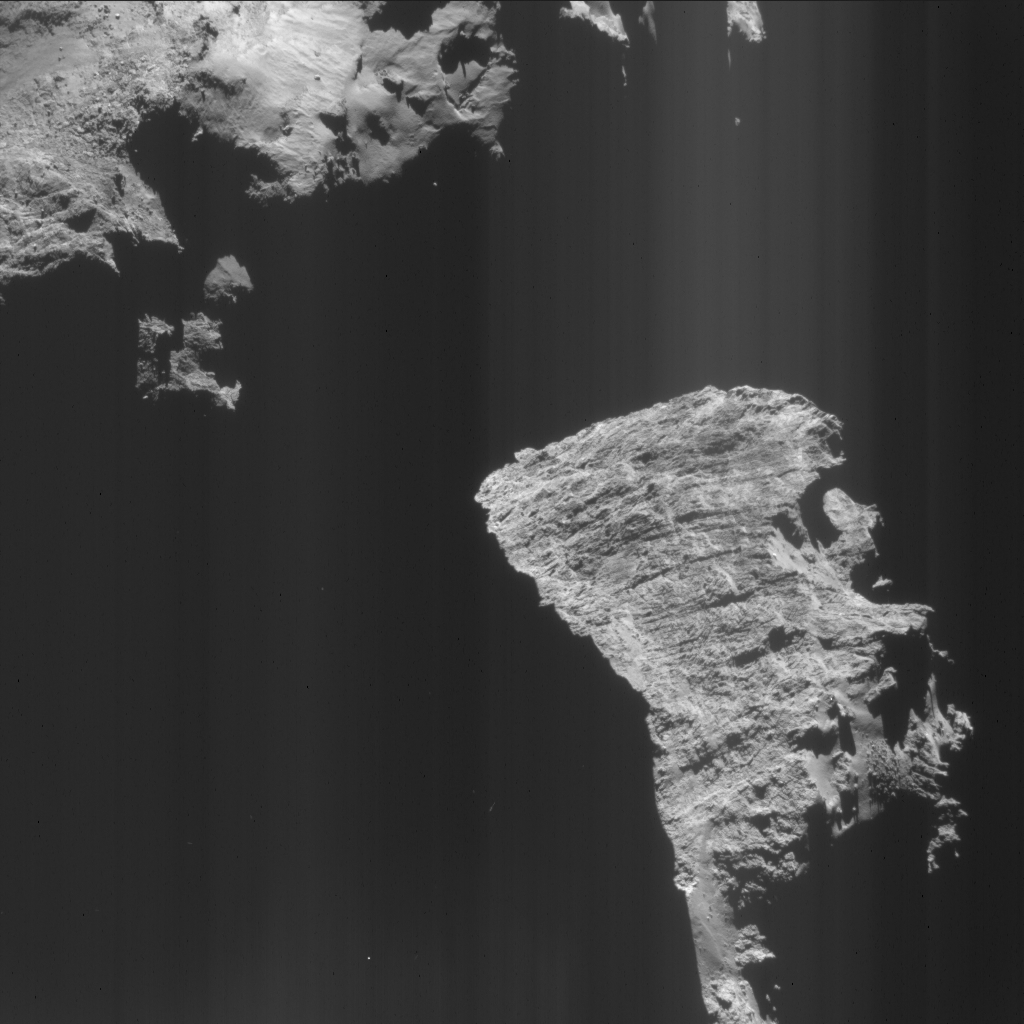Today’s CometWatch entry, also featured as ESA Space Science Image of the Week, is an image of Comet 67P/Churyumov-Gerasimenko taken with Rosetta’s navigation camera (NAVCAM) on 30 June 2016, from a distance of 25.8 km.

Enhanced NAVCAM image of Comet 67P/C-G taken on 30 June 2016, 25.8 km from the nucleus. The scale is 2.2 m/pixel and the image measures 2.3 km across. The faint vertical striping effect is an image artifact. Credits: ESA/Rosetta/NAVCAM – CC BY-SA IGO 3.0
Depicted in the lower right part of the image is the region Hathor, a very intriguing portion of the small comet lobe, where the head declines steeply towards the neck and body of the comet.
This view shows a good fraction of the 900-m high cliff that forms Hathor, with marked linear features crossing the region from left to right. Perpendicular to these, additional streaks and even small terraces can be seen. Beyond the cliff of Hathor, on the right, are hints of the Ma’at region.
In the upper right corner, smoother patches of the large comet lobe are visible, covered in dust and boulders. The large lobe casts its shadow on the comet’s neck, which separates the two lobes and is hidden from view in this image.
Meanwhile, Rosetta’s OSIRIS wide-angle camera obtained this stunning image of a different portion of the comet on 2 July, when the spacecraft was 14.5 km from the nucleus.

OSIRIS wide-angle camera image taken on 2 July 2016, when Rosetta was 14.5 km from Comet 67P/C-G. The scale is 1.38 m/pixel and the image measures about 2.8 km. Credits: ESA/Rosetta/MPS for OSIRIS Team MPS/UPD/LAM/IAA/SSO/INTA/UPM/DASP/IDA
The image shows most of the large comet lobe, with the Khonsu, Atum and Anubis regions well in sight, from left to right, and hints of Seth towards the right edge. In the lower right corner, the smooth region of Hapi is visible, on the neck, leading towards the rougher Anuket.
Another striking image, featuring smooth-covered terrains in the Babi region, on the large comet lobe, was taken with the OSIRIS narrow-angle camera on 3 July, when Rosetta was about 11 km from the nucleus.

OSIRIS narrow-angle camera image taken on 3 July 2016, when Rosetta was 11.2 km from Comet 67P/C-G. The scale is 0.20 m/pixel and the image measures about 410 m. Credits: ESA/Rosetta/MPS for OSIRIS Team MPS/UPD/LAM/IAA/SSO/INTA/UPM/DASP/IDA
Currently, Rosetta is on a 27 km x 9 km elliptical orbit around the nucleus; this weekend, it will move to a less eccentric, 9 km x 10 km orbit, ahead of entering the end-of-mission orbit. The mission will continue its close-up investigation of the comet environment until the grand finale, a controlled descent of the spacecraft to the surface of the comet on 30 September.
The original NAVCAM image is provided below.










Discussion: 5 comments
Hi Claudia
OSIRIS don’t seem to be doing context squares for the location of their photos any more. I’ve therefore done context squares for their close ups of the 4th, 8th and 11th of July. The 8th of July is the Babi photo in this post. Please scroll to “COMMENT 6”.
https://scute1133site.wordpress.com/photos-for-off-site-comments/
The Babi context square has a left hand side that’s a tad too far to the left. When dotting I have to do it from memory of the original. These are otherwise fairly accurate and good enough for context but all are judged by eye.
@A. Cooper,
If you’re getting the images via the automated e-mail system, then you should be getting the context images. I certainly have – there are always two images per e-mail. Unfortunately I’ve only kept the main images.
Thanks ianw16
I shall probably sign up for emails. I didn’t sign up before because half my Twitter followees (horrible word) pounce on the new releases so I click through to the OSIRIS website from their tweets. It seems strange not to put the context squares on the site pictures but include them with the emailed ones.
Whilst the emailed ones mean the context squares are released to the public in some form, the result of not putting them on the OSIRIS site is confusion. Many of those followees of mine are well-known astronomers, astronomy bloggers and science reporters. It’s clear from their tweets that, if it’s a close-up, they haven’t a clue where it is on the comet.
Another problem is the mirror-flipping. About 10-20% are mirror flipped, and again, people don’t seem to realise. This can lead to a lot of head-scratching and misinterpretation, especially for those who are already somewhat familiar with the surface features but not familiar enough to catch it.
Yesterday’s release of the Anuket neck, Seth and Ash is a good example:
https://planetgate.mps.mpg.de/Image_of_the_Day/public/OSIRIS_IofD_2016-07-13.html
It’s mirror-flipped and even I started tracking right from the obvious neck landmarks, expecting to see certain features which weren’t where they were supposed to be. It only took me a few seconds to see it was mirror-flipped because of experience in catching them but the first time it happened it was a minute or so.
The closer in you go, the harder it is to catch it because there are fewer large-scale landmarks to go by. So people with a deeper than cursory interest, including scientists, may get their interpretations wrong. A misinterpreted mirror flip could appear to undermine stretch theory because Marco and I look for expected delaminated features either side of that central portion of the neck that’s on the horizon in that recent OSIRIS picture. We knew the shape to expect, say southwards from that horizon point and were awaiting the first hi-res and well-lit pics in that region. Those only came out a few weeks ago (OSIRIS versions as opposed to NAVCAM). If they had been flipped we would have seen the northern side where the southern side should be and not seen the expected shape. That would be one small nail in the coffin for stretch theory. Fortunately, we’re both familiar with every square inch of the neck so we’ll recognise the northern features transplanted to the south when it happens. But the closer in OSIRIS goes, the harder it is to pick up mirror-flipped versions. For some non-OSIRIS scientists that would be a major issue.
Phil Plait retweeted the mirror-flipped one of the neck, linked above. He has nearly half a million followers who trust that he knows the comet well because he regularly posts on it. So those of his followers who know the comet fairly well but not well enough to catch the flip are going to start getting confused. 67P appears to change its general shape and character anyway, even from similar viewpoints on non flipped photos so it would be reasonable for these people to think the flip was yet another weirdly changing perspective and lighting/relief phenomenon.
Perhaps the emailed ones show the mirror-flip? I’ll sign up anyway
Oh, and did we see the expected matches in the south, emerging from winter obscurity when those pics eventually came out? Of course we did!…
https://twitter.com/scute1133/status/750329167414173696
https://twitter.com/scute1133/status/750337842858123264
Dear A.Cooper,
Indeed, the context image that was sent via the automatic email system along with the 4 July WAC image showed the correct orientation of the comet.
The flipped image was also posted in the latest CometWatch post: https://blogs.esa.int/rosetta/2016/07/15/cometwatch-9-july/
Best wishes
Congradulations,Wonderful,Dr.Amalia Kokkinou